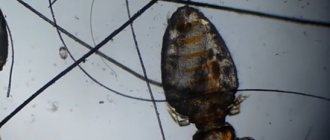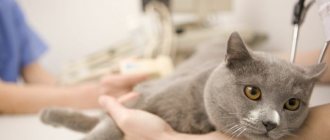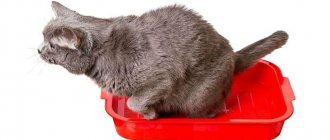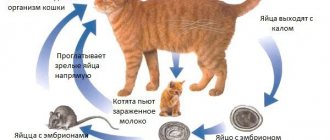Before talking about liver disease in cats, pet owners should have an idea of its role and the function that the liver performs in the cat's body.
Due to its diverse and complex functions in the body, the liver is simultaneously an organ of digestion, circulation and metabolism.
It is located in the anterior part of the abdominal cavity, lies directly behind the diaphragm, mostly in the area of the right hypochondrium.
The liver in the animal’s body plays a very important role in metabolism, participating in the exchange of carbohydrates, fats, proteins, vitamins, microelements and water.
The liver neutralizes toxic substances that enter it from the intestines. The liver maintains normal blood sugar levels; glycogen is deposited and broken down in the liver. In lactating cats, many milk precursors are synthesized in the liver.
In the process of fat metabolism, phosphatides are synthesized in the liver, which subsequently enter the blood. The body's proteins are synthesized from amino acids carried through the bloodstream to the liver. The liver is a blood depot; up to 10% of a cat's total blood is in the liver.
During the process of transamination in the liver, the amount of amino acids contained in excess in the body decreases and the missing ones increase. The liver in animals is a reserve “depot” of proteins. Blood plasma proteins (albumin, globulins, fibrinogen, prothrombin) are formed in the liver, from where they enter the blood. Protein renewal occurs in the liver. The liver stores vitamins “A” and “D”, microelements – iron, copper, manganese, zinc. The liver breaks down hormones such as thyroxine, insulin, ACTH, vasopressin, and sex hormones.
A specific function of the liver is bile formation.
The liver has an incredible ability to regenerate. Up to 75% of all hepatocytes (liver cells) work in the liver at the same time, so the liver always has reserves. Even in the case of severe liver damage by some kind of poison, if the cat still has at least a small number of healthy cells, the doctor has a chance for a successful outcome of this or that disease.
Main symptoms of liver disease in cats.
Liver disease in cats is characterized by a number of signs that should alert its owner. An owner can suspect liver disease in their cat based on the following symptoms:
- Vomiting in a cat.
- Cat has diarrhea.
- Jaundice, in which icteric staining of the mucous membranes and subcutaneous tissue occurs in a yellow color.
- Skin itching.
- Change in urine color, from yellow to brown.
- Change in color of feces from brown to gray or brown.
- Abdominal dropsy, ascites – an increase in the volume of the abdomen due to the accumulation of fluid in the abdominal cavity.
- An increase in the size of the liver, which manifests itself as a protrusion through the abdominal wall.
- Pain in the liver area (hepatic colic).
- Multiple hemorrhages in the skin and subcutaneous tissue.
- Poor blood clotting.
Major liver diseases in cats.
Hepatitis is the general name for inflammatory diseases of the liver tissue. Hepatitis often occurs simultaneously with diseases of the stomach, intestines, pancreas and other organs. With hepatitis, the gallbladder and bile ducts are almost always involved in the process. Hepatitis is accompanied by profound disturbances in protein, carbohydrate-fat and pigment metabolism, and liver cells disintegrate.
In its course, hepatitis can be acute or chronic.
Etiology. Hepatitis in cats rarely occurs as an independent disease and is usually a secondary manifestation of various infectious, invasive diseases and intoxication with poisons of plant and mineral origin. The development of hepatitis is facilitated by reduced resistance of the cat’s body, functional weakening of the liver due to congestion in the venous system.
Clinical signs. When conducting a clinical examination of a sick cat, a veterinarian finds jaundice, an icteric yellow discoloration of the visible mucous membranes, conjunctiva and skin. In some sick cats, owners report loss of appetite, increased thirst, increased body temperature, and symptoms of diarrhea or constipation. Fecal matter is grayish-yellow in color, urine color changes from yellow to dark yellow. In severe cases of hepatitis, the cat experiences convulsions.
A veterinarian makes a diagnosis of hepatitis based on clinical signs of the disease and laboratory testing of blood and urine for bilirubin.
Treatment. Treatment of hepatitis in a cat depends on the cause that caused its development. A sick cat is prescribed a diet that does not contain fatty foods. On the first day of treatment, the cat is put on a starvation diet, after which it is switched to feeding porridge; after a week, minced meat is gradually introduced into the feeding diet. Among the medications, the cat is prescribed B vitamins and preparations containing choline (Essentiale, etc.). To reduce pain and eliminate congestion in the liver, antispasmodics are used. Aminazine and fosprenil are used to relieve acute conditions in liver failure. If there are signs of dehydration, a saline drip. To relieve intoxication, injections of glucose with vitamin C. To eliminate an allergic reaction, antihistamines. Conducting antibiotic therapy. For hepatitis, herbal infusions are taken, which have a diuretic and choleretic effect.
How does the liver work?
The liver is the largest gland of the body, the main task of which is to neutralize and remove poisons from the body (including metabolic products), excess hormones, mediators, and vitamins. To do this she:
- filters out fat-soluble toxins, turning them into water-soluble substances;
- produces enzymes that break down drugs and other chemical compounds.
The more poisons in the body, the heavier the liver. Toxins kill her cells (hepatocytes), and regeneration takes time. While the new cell grows, the load on nearby tissues increases.
If there are too many poisons, hepatocytes can die en masse, then connective tissue appears in their place. Although it closes the hole, it is unable to perform the work of the liver. Intoxication of the body begins, which can cause death.
Other liver functions
Neutralization of poisons is the main, but not the only task of the liver. She:
- Participates in lipid and carbohydrate metabolism.
- Produces proteins, incl. albumins, which carry hormones and other substances to cells.
- Stores minerals, glycogen, triglycerides.
- Activates vitamins.
- Synthesizes substances that are involved in blood clotting.
- Produces bile acids and enzymes.
The liver processes bilirubin, a pigment formed after the breakdown of red blood cells. This is a very toxic substance, which the organ neutralizes and sends as part of bile to digest food. The pigment then passes into the stool and leaves the body.
Excess bilirubin in the blood is the cause of yellowing of the mucous membranes in animals. The pigment is sent not into the bile, but into the plasma, so the stool, to which it gives a dark color, becomes discolored. The urine becomes the color of beer because the bilirubin has to be excreted by the kidneys.
Diagnostics
Only a veterinarian can make a correct diagnosis of a pet - the doctor will collect anamnesis and examine the sick animal. To diagnose cirrhosis, you will need palpation of the liver: it involves palpation to determine the presence of fluid in the peritoneum and the enlargement of the organ.
However, a clinical examination cannot give a complete picture of the disease; sometimes with cirrhosis the liver atrophies. To make an accurate diagnosis, additional methods are used:
- serological test for the detection of infectious agents - determining the root cause of cirrhosis;
- urine analysis - identifying existing pathologies and possible kidney problems, as well as the presence of protein and bilirubin, indicating liver dysfunction;
- blood test for ESR - detection of inflammation in the body;
- biochemical blood test for sugar, enzymes and bilirubin;
- Ultrasound to determine the size and condition of the organ - an enlarged spleen indicates cirrhosis;
- radiography - assessment of the shape, borders and location of the liver.
Sometimes a biopsy is used to diagnose the disease - the cat is given general anesthesia and the peritoneum is pierced with a thin needle to take material for analysis. The method helps to distinguish cirrhosis from other liver pathologies.
Symptoms of a diseased liver in animals
Failures in the liver negatively affect the functioning of all organs and systems. This explains the first symptoms of the disease - fatigue, bad mood, decreased activity, irritability, aggression. The appetite gradually worsens, the dog suddenly loses weight, thirst appears, and discharge from the eyes appears. The temperature may rise.
Over time, symptoms characteristic of a diseased liver develop:
- yellowing of the mucous membranes of the eyes, mouth, gums;
- digestive problems – vomiting, diarrhea, bloating;
- dark urine;
- seizures and other neurological problems;
- gastrointestinal bleeding due to poor coagulation, the appearance of ulcers;
- accumulation of fluid in the abdomen, due to which one may mistakenly assume that the pet has gained weight (extreme stage, a symptom of imminent death).
Treatment
Since cirrhosis is an incurable pathology, all therapy is aimed at treating the primary disease that provoked liver destruction. The treatment regimen is as follows:
- To restore the water-salt balance in case of dehydration, intravenous administration of physiological solutions is prescribed.
- Vitamin preparations such as vitamin C and B₆ are used.
- To increase the regenerative properties of the liver, as well as to maintain the functioning of the parenchymal organ, hepatoprotectors are used.
- Diuretic medications are prescribed to eliminate the accumulation of excess fluid in the peritoneum.
- When diagnosing helminthic infestation, deworming is indicated.
- Vikasol is effective for internal and external bleeding.
- The use of antimicrobial drugs is mandatory to reduce the risk of developing hepatitis.
- If anemia occurs, iron supplements are administered or blood transfusions are performed.
Drug therapy is not the only thing you need to focus on during the cat’s treatment period. A sick animal also needs a strict balanced diet, high-quality care, and a decrease in physical activity.
Causes of liver disease in animals
The liver destroys toxins through oxidative processes, so free radicals accumulate in it. In large quantities they are dangerous because they damage the gland and slow down cell regeneration.
The heavier the poisons that the organ must neutralize, the more free radicals the liver produces, the higher the risk of damage to hepatocytes. The solution is to reduce the cat or dog’s exposure to toxins.
Liver problems in pets are caused by medications and chemicals:
- Anthelmintic drugs. They must be given to prevent the development of parasites, but in no case exceed the dosage.
- Flea and tick medications, tablets are especially dangerous.
- Vaccination. The injection protects the pet from fatal diseases, but creates additional stress on the liver.
- Household chemicals – products for cleaning carpets, floors, furniture.
- Pesticides and herbicides are a problem often faced by pets living in the countryside or in the country.
- Nutritional supplements.
- Heavy metals.
Who's at risk
Liver dysfunction is common in older dogs and cats. Also among the reasons are obesity, prolonged fasting, stress, tattoos, microchips. Liver problems can be caused by:
- pancreatitis;
- oncology of other organs;
- sick kidneys;
- worms;
- viral, bacterial infections;
- autoimmune pathologies;
- hormonal imbalances.
The liver can fail due to a sudden change in nutrition (for example, when switching from natural food to ready-made food), an overdose of vitamins and minerals. Cheap food can cause poisoning.
Some dog breeds have a genetic predisposition to liver disease:
- Dobermans;
- Rottweilers;
- Yorkshire Terriers;
- cocker spaniels;
- Bedlington Terriers;
- West Highland White Terrier.
These breeds have a hereditary condition associated with copper accumulation in the liver. With the help of this substance, iron produces some enzymes, but excess copper causes damage to the proteins that bind it. The result is inflammation of the gland, cirrhosis.
Two types of deficiency
Acute form.
In addition to the listed symptoms, the pet may have mental disorders. The cat is constantly tormented by bouts of vomiting and is disoriented. This is a sad picture, and if you do not seek veterinary help in time, the animal will go into shock. In most cases, the acute form of liver failure is easily treatable, but this requires hospitalization.
Chronic form.
In this case, the process lasts several months and it is more difficult to save it.
What can I advise you, dear friends?
Major liver diseases in animals
There are many pathologies that are caused by the liver. Diseases can be divided into 3 groups:
- Inflammatory infectious diseases - liver abscess in cats, leptospirosis, viral hepatitis, adenovirus type 1 in dogs.
- Inflammatory non-infectious – lymphocytic cholangitis in cats, chronic hepatitis in dogs.
- Non-inflammatory – hepatosis in cats, copper accumulation in dogs.
Hepatitis
Most often, dogs encounter infectious (viral) hepatitis - inflammation of the liver. The pathology is difficult, fast, and often ends in the death of the pet. Other types of hepatitis that occurs in animals are caused by worms and bacteria. Inflammation of the liver can be a consequence of diseases of the pancreas and digestive system.
Hepatosis
Hepatosis occurs more often in cats. The pathology develops due to the accumulation of fat in the liver cells, which leads to its degeneration. The disease is a consequence of obesity, hormonal imbalances, and poor nutrition, which cause inflammation of the liver. The pathology is dangerous; if left untreated, it often develops into cirrhosis.
Amyloidosis
The disease is characterized by a disorder of protein metabolism, when amyloid, a fibrous substance, is deposited in tissues and causes cell death. Pathology can affect different organs, incl. liver.
Cirrhosis
The disease develops slowly and usually ends in death. As liver cells die, they are replaced by connective tissue, and it cannot cope with its tasks. The animal dies from intoxication, thrombosis, and internal bleeding.
A characteristic sign of cirrhosis is ascites, the accumulation of fluid in the abdominal cavity. It puts pressure on the diaphragm, causing blood stagnation, ulcers, increased pressure in the liver area, and other problems.
Causes of cirrhosis in animals:
- low-quality food containing poisons;
- deficiency of selenium, pyridoxine, and some other elements;
- hepatitis, hepatosis, inflammation of the gallbladder;
- parasites (pyroplasmosis, toxocariasis);
- plague, enteritis.
Liver cancer
Cancer is a condition where cells begin to divide abnormally and do not die. They displace healthy tissues, but cannot replace them, which leads to the death of the body. Liver cancer often develops as a secondary disease when malignant cells from a tumor located in another part of the body enter the gland.
Less commonly, cancer occurs in the liver itself. It is usually a consequence of cirrhosis. Another reason may be long-term exposure to carcinogenic factors (eg, heavy metals).
Risk group
Cirrhosis is not transmitted by any means. It represents the slow replacement of liver tissue with scar compounds. Hidden hepapathologies are understood as diseases in which the clinical picture is mild, and the characteristic signs are either just outlined or hidden under other diseases. All animals are susceptible to liver cirrhosis, cats are no exception. Those at risk for developing this pathology include pets with weakened immune systems, the elderly, or those using medications that have a detrimental effect on the organ. In addition, cirrhosis is a consequence of concomitant pathologies.
Therapy
To treat and restore liver function, the doctor prescribes medications from the following groups:
- Hepatoprotectors (Hepatovet, Hepatolux, Hepasafe) - improve metabolic processes in the liver, increase its resistance to toxins, and stimulate cell regeneration.
- Choleretic drugs (preparations with milk thistle) - accelerate the formation of bile in the liver, promote its removal from the gallbladder to the intestines.
- Sorbents (Simbosorb, EnteroZoo) - absorb toxins, reducing the load on the liver.
For cirrhosis, the doctor may prescribe injections of glucose, insulin, and vitamins. Diuretics will help remove ascites. To relieve inflammation, hormonal drugs are prescribed. Cancer requires chemotherapy and surgery.
Unfortunately, cirrhosis and liver cancer often result in death, but therapy can prolong the life of a pet and relieve pain.
Diet
Treatment of any liver disease involves diet. Proper nutrition will reduce the load on the gland, which promotes recovery, and if healing is not possible, it will improve your well-being. Give food that is light but nutritious, rich in all nutrients. Products should not irritate the digestive tract.
Discuss the diet with your veterinarian. He will recommend the right food if the animal is on a natural diet, and will recommend healthy products. If your dog has copper hepatopathy, your doctor will prescribe a diet low in copper and high in zinc.
Forecast
Even the most experienced specialist is unable to cure an animal from cirrhosis.
Destroyed liver cells can no longer be restored, so the disease is considered incurable. As a rule, cats with cirrhosis live on average only 1 year, but if the necessary therapy is carried out, the life of a sick animal can be extended, it all depends on the degree of neglect of the disease.
A sick animal requires a constant diet, the use of painkillers, hepatoprotectors, and other necessary therapy.
Prevention
Monitor your pet's diet. Do not feed your dog or cat food from the table. Buy only high-quality, proven food. If your pet is on a natural diet, give raw lean meat, boiled fish, fresh vegetables and fruits. Wipe or steam the greens for better absorption. Avoid sausages, sausages, do not give rotten, bad food.
Other recommendations:
- Remove toxins that may harm the liver. This means that you need to avoid unnecessary pesticides and medications. Avoid frequent cleaning using household chemicals.
- Synthetic vitamins and minerals can be given strictly according to the instructions, without exceeding the course duration and dose.
- Supplement with the antioxidants glutathione, the amino acids N-acetylcysteine (NAC) and S-adenosylmethionine (SAMe). They bind to toxins in the liver before the poisons can damage the gland. Be sure to consider the dosage.
- Get vaccinated against deadly diseases on time.
Effect of taking
The drug is prescribed to cats for pathologies of the liver and gall bladder. It has the following effects on the animal’s body:
- protects liver cells from harmful influences;
- prevents congestion in the liver;
- improves bile flow.
This is the most gentle drug for the treatment of cirrhosis in cats. It rarely causes side effects. This drug can be replaced with other human medications only after consultation with a specialist, since many drugs for humans have a negative effect on the animal’s body.
Clinical manifestations
What are the signs to determine that your beloved domestic cat’s liver has failed? Alas, at first only the most general, nonspecific symptoms appear:
Vomit.
Loss of appetite.
The cat is losing weight.
A strong, unquenchable thirst appears (indicating significant intoxication).
The feces (most often) become paler than usual, but the urine takes on a rich, orange color.
And only then the signs of liver failure in cats become more pronounced and “intelligible”. Firstly, the volume of the abdomen increases significantly. Even if it’s a cat and there’s no risk of pregnancy in any way. This happens due to ascites (edema of the abdominal cavity). The mechanism of its development is simple: the volume of the liver decreases, the organ becomes denser, the mouth of the portal vein is compressed, resulting in effusion. If at this moment you press in the area of the right hypochondrium, the animal will show all the signs of a strong pain reaction. At the same time, pronounced yellowness of the mucous membranes and skin develops. The general condition of the animal is serious, the cat constantly lies down, he is apathetic and does not show any interest even in the most delicious food. If nothing is done, seizures and other signs of damage to the nervous system appear.
Preventive actions
Liver disease in cats is easier to prevent than to cure.
Follow these rules to protect your pet from serious illness.
- Choose only high-quality food with a good shelf life. Follow the rules for storing dry food.
- With a natural diet, monitor the balance of proteins, carbohydrates, fats, vitamins and minerals.
- Strictly adhere to the dosage prescribed by your veterinarian when giving your cat medications.
- Do not overfeed your cat with vitamin and mineral complexes; give them strictly as prescribed by the veterinarian.
- Do not allow the animal to come into contact with dangerous toxic substances and poisons.
- Follow your vaccination schedule strictly.
- Treat your pet against parasites once a quarter.
- Minimize stressful situations for your pet.











